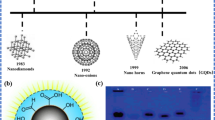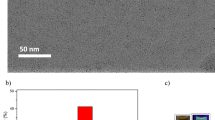Abstract
Sulfur and nitrogen co-doped carbon dots (NSCDs) were quickly synthesized by the microwave-assisted method from tri-ammonium citrate and thiourea. NSCDs showed a quantum yield of 11.5% with excitation and emission bands at 355 and 432 nm, respectively. Also, a fluorescence quenching was observed in the presence of Pb(II) ions, and the as-synthesized CDs were used as a sensitive probe for detecting Pb(II) in water and food samples. The results showed the optimal conditions for Pb(II) determination were CDs concentration of 0.02 mg mL−1 at pH 6.0–7.0 and an incubation time of 20 min. The relative fluorescence intensity of NSCDs was proportional to Pb(II) concentrations in the range of 0.029–2.40 and 2.40–14.4 µmol L−1 with a correlation coefficient (R2) of 0.998 and 0.955, respectively, and a detection limit of 9.2 × 10–3 µmol L−1. Responses were highly repeatable, with a standard deviation below 3.5%. The suggested method demonstrates the potential of a green, fast, and low-cost approach for Pb(II) determination in water, tea, and rice samples with satisfying results.




Similar content being viewed by others
Data availability
All data generated or analyzed during this study are included in this manuscript.
Code availability
A statement regarding code availability is not applicable.
Abbreviations
- AAS:
-
Atomic absorption spectrometry
- CDs:
-
Carbon dots
- DLS:
-
Dynamic light scattering
- EtOH:
-
Ethanol
- FL:
-
Fluorescence
- ICP-MS:
-
Inductively coupled plasma-mass spectrometry
- ICP-OES:
-
Inductively coupled plasma-optical emission spectrometry
- MeOH:
-
Methanol
- QDs:
-
Quantum dots
- QY:
-
Quantum yield
- SEM:
-
Scanning electron microscope
- TAC:
-
Tri-ammonium citrate
- TEM:
-
Transmission electron microscope
References
Qu J, Yuan Y, Zhang X, Wang L, Tao Y, Jiang Z, Yu H, Dong M, Zhang Y (2022) Stabilization of lead and cadmium in soil by sulfur-iron functionalized biochar: Performance, mechanisms and microbial community evolution. J Hazard Mater 425:127876. https://doi.org/10.1016/j.jhazmat.2021.127876
Payehghadr M, Esmaeilpour S, Kazem Rofouei M, Adlnasab L (2013) Determination of trace amount of cadmium by atomic absorption spectrometry in table salt after solid phase preconcentration using octadecyl silica membrane disk modified by a new derivative of pyridine. J Chem 2013:1–6. https://doi.org/10.1155/2013/417085
Qu J, Wei S, Liu Y, Zhang X, Jiang Z, Tao Y, Zhang G, Zhang B, Wang L, Zhang Y (2022) Effective lead passivation in soil by bone char/CMC-stabilized FeS composite loading with phosphate-solubilizing bacteria. J Hazard Mater 423:127043. https://doi.org/10.1016/j.jhazmat.2021.127043
Wang Z-X, Yu X-H, Li F, Kong F-Y, Lv W-X, Fan D-H, Wang W (2017) Preparation of boron-doped carbon dots for fluorometric determination of Pb(II), Cu(II) and pyrophosphate ions. Microchim Acta 184:4775–4783. https://doi.org/10.1007/s00604-017-2526-3
Salmanipour A, Taher MA (2011) An electrochemical sensor for stripping analysis of Pb(II) based on multiwalled carbon nanotube functionalized with 5-Br-PADAP. J Solid State Electrochem 15:2695–2702. https://doi.org/10.1007/s10008-010-1197-3
Deka MJ, Chowdhury D, Nath BK (2022) Recent development of modified fluorescent carbon quantum dots-based fluorescence sensors for food quality assessment. Carbon Lett 32:1131–1149. https://doi.org/10.1007/s42823-022-00347-5
Ju H, Lee MH, Kim J, Kim JS, Kim J (2011) Rhodamine-based chemosensing monolayers on glass as a facile fluorescent “turn-on” sensing film for selective detection of Pb2+. Talanta 83:1359–1363. https://doi.org/10.1016/j.talanta.2010.11.016
Srisukjaroen R, Wechakorn K, Teepoo S (2022) A smartphone based-paper test strip chemosensor coupled with gold nanoparticles for the Pb2+ detection in highly contaminated meat samples. Microchem J 179:107438. https://doi.org/10.1016/j.microc.2022.107438
Li G, Belwal T, Luo Z, Li Y, Li L, Xu Y, Lin X (2021) Direct detection of Pb2+ and Cd2+ in juice and beverage samples using PDMS modified nanochannels electrochemical sensors. Food Chem 356:129632. https://doi.org/10.1016/j.foodchem.2021.129632
Sharma P, Mehata MS (2020) Rapid sensing of lead metal ions in an aqueous medium by MoS2 quantum dots fluorescence turn-off. Mater Res Bull 131:110978. https://doi.org/10.1016/j.materresbull.2020.110978
Baker SN, Baker GA (2010) Luminescent carbon nanodots: emergent nanolights. Angew Chem Int Ed 49:6726–6744. https://doi.org/10.1002/anie.200906623
Liu R, Zhang Y, Piao Y, Meng L-Y (2021) Development of nitrogen-doped carbon quantum dots as fluorescent probes for highly selective and sensitive detection of the heavy-ion Fe3+. Carbon Lett 31:821–829. https://doi.org/10.1007/s42823-020-00222-1
Wee SS, Ng YH, Ng SM (2013) Synthesis of fluorescent carbon dots via simple acid hydrolysis of bovine serum albumin and its potential as sensitive sensing probe for lead (II) ions. Talanta 116:71–76. https://doi.org/10.1016/j.talanta.2013.04.081
Silva J, Gonçalves H (2011) Analytical and bioanalytical applications of carbon dots. TrAC, Trends Anal Chem 30:1327–1336. https://doi.org/10.1016/j.trac.2011.04.009
Qu J, Bi F, Hu Q, Wu P, Ding B, Tao Y, Ma S, Qian C, Zhang Y (2023) A novel PEI-grafted N-doping magnetic hydrochar for enhanced scavenging of BPA and Cr(VI) from aqueous phase. Environ Pollut 321:121142. https://doi.org/10.1016/j.envpol.2023.121142
Hou J, Li H, Wang L, Zhang P, Zhou T, Ding H, Ding L (2016) Rapid microwave-assisted synthesis of molecularly imprinted polymers on carbon quantum dots for fluorescent sensing of tetracycline in milk. Talanta 146:34–40. https://doi.org/10.1016/j.talanta.2015.08.024
Pan D, Zhang J, Li Z, Wu C, Yan X, Wu M (2010) Observation of pH-, solvent-, spin-, and excitation-dependent blue photoluminescence from carbon nanoparticles. Chem Commun 46:3681–3683. https://doi.org/10.1039/C000114G
Gupta A, Verma NC, Khan S, Tiwari S, Chaudhary A, Nandi CK (2016) Paper strip based and live cell ultrasensitive lead sensor using carbon dots synthesized from biological media. Sens Actuators B 232:107–114. https://doi.org/10.1016/j.snb.2016.03.110
Aboobakri E, Jahani M (2020) Graphene oxide/Fe3O4/polyaniline nanocomposite as an efficient adsorbent for the extraction and preconcentration of ultra-trace levels of cadmium in rice and tea samples. Res Chem Intermed 46:5181–5198. https://doi.org/10.1007/s11164-020-04256-y
Wang B, Zhuo S, Chen L, Zhang Y (2014) Fluorescent graphene quantum dot nanoprobes for the sensitive and selective detection of mercury ions. Spectrochim Acta Part A 131:384–387. https://doi.org/10.1016/j.saa.2014.04.129
Pajewska-Szmyt M, Buszewski B, Gadzała-Kopciuch R (2020) Sulphur and nitrogen doped carbon dots synthesis by microwave assisted method as quantitative analytical nano-tool for mercury ion sensing. Mater Chem Phys 242:122484. https://doi.org/10.1016/j.matchemphys.2019.122484
He JH, Cheng YY, Yang T, Zou HY, Huang CZ (2018) Functional preserving carbon dots-based fluorescent probe for mercury (II) ions sensing in herbal medicines via coordination and electron transfer. Anal Chim Acta 1035:203–210. https://doi.org/10.1016/j.aca.2018.06.053
Zhang Y, Cui P, Zhang F, Feng X, Wang Y, Yang Y, Liu X (2016) Fluorescent probes for “off–on” highly sensitive detection of Hg2+ and L-cysteine based on nitrogen-doped carbon dots. Talanta 152:288–300. https://doi.org/10.1016/j.talanta.2016.02.018
Wei J-M, Liu B-T, Zhang X, Song C-C (2018) One-pot synthesis of N, S co-doped photoluminescent carbon quantum dots for Hg2+ ion detection. New Carbon Mater 33:333–340. https://doi.org/10.1016/S1872-5805(18)60343-9
Yu P, Wen X, Toh Y-R, Tang J (2012) Temperature-dependent fluorescence in carbon dots. J Phys Chem C 116:25552–25557. https://doi.org/10.1021/jp307308z
Liu Y, Liu CY, Zhang ZY (2011) Synthesis and surface photochemistry of graphitized carbon quantum dots. J Colloid Interface Sci 356:416–421. https://doi.org/10.1016/j.jcis.2011.01.065
Bao L, Liu C, Zhang Z-L, Pang D-W (2015) Photoluminescence-tunable carbon nanodots: surface-state energy-gap tuning. Adv Mater 27:1663–1667. https://doi.org/10.1002/adma.201405070
Jalili R, Amjadi M (2015) Surface molecular imprinting on silane-functionalized carbon dots for selective recognition of nifedipine. RSC Adv 5:74084–74090. https://doi.org/10.1039/C5RA12189B
Chen Y, Wu Y, Weng B, Wang B, Li C (2016) Facile synthesis of nitrogen and sulfur co-doped carbon dots and application for Fe(III) ions detection and cell imaging. Sens Actuat B. 223:689–696. https://doi.org/10.1016/j.snb.2015.09.081
Sun M, Qu J, Han T, Xue J, Li K, Jiang Z, Zhang G, Yu H, Zhang Y (2023) Resource utilization of bovine bone to prepare biochar as persulfate activator for phenol degradation. J Cleaner Prod 383:135415. https://doi.org/10.1016/j.jclepro.2022.135415
Barati A, Shamsipur M, Arkan E, Hosseinzadeh L, Abdollahi H (2015) Synthesis of biocompatible and highly photoluminescent nitrogen doped carbon dots from lime: analytical applications and optimization using response surface methodology. Mater Sci Eng C 47:325–332. https://doi.org/10.1016/j.msec.2014.11.035
Hou Y, Lu Q, Deng J, Li H, Zhang Y (2015) One-pot electrochemical synthesis of functionalized fluorescent carbon dots and their selective sensing for mercury ion. Anal Chim Acta 866:69–74. https://doi.org/10.1016/j.aca.2015.01.039
Wang W, Damm C, Walter J, Nacken T, Peukert W (2015) Photobleaching and stabilization of carbon nanodots produced by solvothermal synthesis. Phys Chem Chem Phys. https://doi.org/10.1039/C5CP04942C
Xiong W, Zhou L, Liu S (2016) Development of gold-doped carbon foams as a sensitive electrochemical sensor for simultaneous determination of Pb (II) and Cu (II). Chem Eng J 284:650–656. https://doi.org/10.1016/j.cej.2015.09.013
Fu X, Lou T, Chen Z, Lin M, Feng W, Chen L (2012) “Turn-on” fluorescence detection of lead ions based on accelerated leaching of gold nanoparticles on the surface of graphene. ACS Appl Mater Interfaces 4:1080–1086. https://doi.org/10.1021/am201711j
Molaei MJ (2020) Principles, mechanisms, and application of carbon quantum dots in sensors: a review. Anal Methods 12:1266–1287. https://doi.org/10.1039/C9AY02696G
Li W, Hu X, Li Q, Shi Y, Zhai X, Xu Y, Li Z, Huang X, Wang X, Shi J, Zou X, Kang S (2020) Copper nanoclusters @ nitrogen-doped carbon quantum dots-based ratiometric fluorescence probe for lead (II) ions detection in porphyra. Food Chem 320:126623. https://doi.org/10.1016/j.foodchem.2020.126623
Liu Y, Zhou Q, Yuan Y, Wu Y (2017) Hydrothermal synthesis of fluorescent carbon dots from sodium citrate and polyacrylamide and their highly selective detection of lead and pyrophosphate. Carbon 115:550–560. https://doi.org/10.1016/j.carbon.2017.01.035
Wang Q, Zhang S, Ge H, Tian G, Cao N, Li Y (2015) A fluorescent turn-off/on method based on carbon dots as fluorescent probes for the sensitive determination of Pb2+ and pyrophosphate in an aqueous solution. Sens Actuat B 207:25–33. https://doi.org/10.1016/j.snb.2014.10.096
Jiang Y, Wang Y, Meng F, Wang B, Cheng Y, Zhu C (2015) N-doped carbon dots synthesized by rapid microwave irradiation as highly fluorescent probes for Pb2+ detection. New J Chem 39:3357–3360. https://doi.org/10.1039/C5NJ00170F
Liu Y, Zhou Q, Li J, Lei M, Yan X (2016) Selective and sensitive chemosensor for lead ions using fluorescent carbon dots prepared from chocolate by one-step hydrothermal method. Sens Actuat B 237:597–604. https://doi.org/10.1016/j.snb.2016.06.092
Tabaraki R, Sadeghinejad N (2018) Microwave assisted synthesis of doped carbon dots and their application as green and simple turn off–on fluorescent sensor for mercury (II) and iodide in environmental samples. Ecotoxicol Environ Saf 153:101–106. https://doi.org/10.1016/j.ecoenv.2018.01.059
Acknowledgements
The authors appreciate the support of the Ferdowsi University of Mashhad (No. 3/54203).
Funding
The authors do not receive a specific project grant but this work was supported by the block grant available to the Ferdowsi University of Mashhad received by Elias Aboobakri as a Ph. D candidate.
Author information
Authors and Affiliations
Contributions
All authors contributed to the study conception and design. The first draft of the manuscript was prepared by Elias Aboobakri and all authors commented on previous versions of the manuscript. All authors read and approved the final manuscript. EA: investigation, data curation, writing—original draft. TH: supervision, methodology, formal analysis, investigation, review and editing of the original draft. MJ: supervision, methodology, resources, review and editing of the original draft.
Corresponding author
Ethics declarations
Conflict of interest
The authors declare that they have no conflict of interest.
Ethical approval
This article does not contain any studies with human or animal subjects.
Consent to participate
Not applicable.
Consent for publication
The authors hereby consent to the publication of the work.
Additional information
Publisher's Note
Springer Nature remains neutral with regard to jurisdictional claims in published maps and institutional affiliations.
Supplementary Information
Below is the link to the electronic supplementary material.
Rights and permissions
Springer Nature or its licensor (e.g. a society or other partner) holds exclusive rights to this article under a publishing agreement with the author(s) or other rightsholder(s); author self-archiving of the accepted manuscript version of this article is solely governed by the terms of such publishing agreement and applicable law.
About this article
Cite this article
Aboobakri, E., Heidari, T. & Jahani, M. N, S co-doped fluorescent carbon dots synthesized by microwave irradiation: a sensitive probe for Pb (II) ions detection in food samples. Carbon Lett. 33, 1629–1638 (2023). https://doi.org/10.1007/s42823-023-00529-9
Received:
Revised:
Accepted:
Published:
Issue Date:
DOI: https://doi.org/10.1007/s42823-023-00529-9




